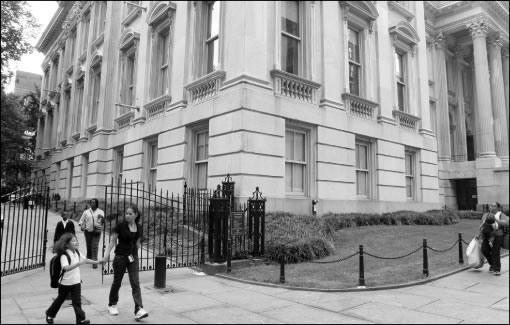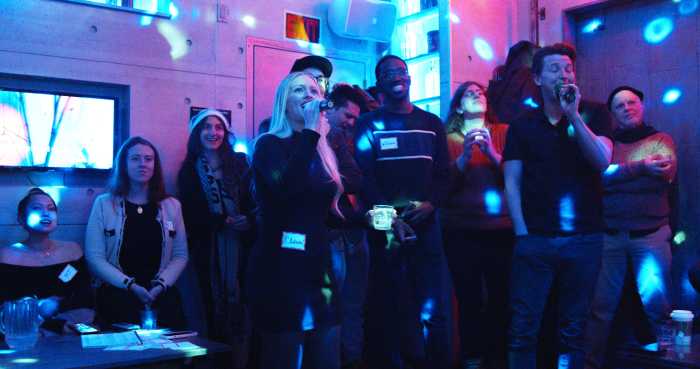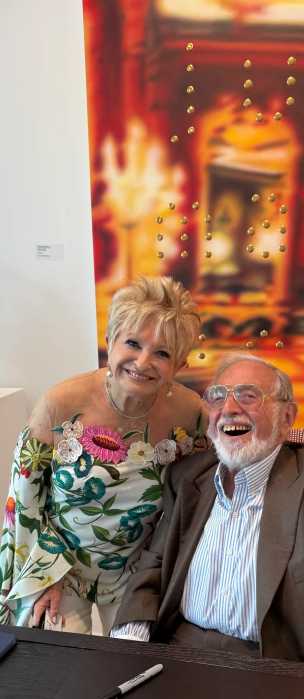By Sisi Wei
After three weeks of professional development, Ross Global Academy teachers had their classrooms set up perfectly. By the end of the school day, the one skewed bubble letter no longer mattered.
“Teachers are really neurotic,” said Bryan Rosenberg, the school’s director of curriculum. “You know? Because everything has to be perfect.”
Rosenberg smiled as he started gesturing about how “these books have to be here, those decorations have to be there … and sometimes [teachers] forget that their audience really couldn’t care less. The first day of school reminds us that our work really starts with the students.”
Leah Gooch, a first year art teacher at Ross, made a mini-breakthrough with her students on Sept. 2. At the beginning of class, students ran up to Gooch and tapped her on the shoulder to get her attention. Turning them all away, Gooch told students over and over that if they wanted her attention, they needed to sit in their seats and raise their hands.
At the end of the period, one student “who had been tapping me all day” came over to tap Gooch once again. “But this time, he looked at me, his eyes grew real wide, and he said, ‘Oh yeah. Sorry. I gotta go sit down and raise my hand.’ ”
Ross Global Academy, a New York City public charter school, was started by philanthropist Courtney Ross in 2006. Originally slated by the New York City Department of Education to be housed in NEST, a K-12 on the Lower East Side, R.G.A. was moved to D.O.E.’s Chambers St. headquarters in Tweed Courthouse after months of protests by NEST parents resulting in a court appearance.
The academy is based off its sister school, a private school started by Ross in the Hamptons, and serves kindergarten through third grade in its lower school at Tweed and sixth through eighth grade in its middle school on 55 East 25th St., which shares space with the School for the Physical City High School. R.G.A., which has about 330 students, hopes to expand towards a K-12 school.
But in the two school years since its opening, this fall being the school’s third year, the academy has gone through its share of hurdles — including high teacher and administration turnover rates, disciplinary problems and test-tampering allegations.
According to a New York Sun article published in June, a school official said that “many teachers quit and many were fired in the middle of the last school year, and nearly all staff members chose not to return to the school this year.” The fifth principal since the school’s beginning, Julie Johnson took over when the previous principal, Stephanie Clagnaz, left last May. Last year was Johnson’s first year as an associate principal with R.G.A.
This fall, “most of the teachers are new,” Gooch said. But she feels that a high number of new teachers has built community. “Because there’s so many of us, we aren’t afraid to ask questions and the teachers who worked here last year are really helpful.”
Especially after professional development — which included a one-week hotel stay near the East Hampton sister school campus — Gooch feels extremely close to this year’s staff.
“There’s been turnover in teachers and there’s been turnover in leadership,” said Rosenberg, who has also worked as an education information specialist and English teacher at the school. “But [being here] takes a pioneer spirit that not all people have in them.”
“If you want to grow something and see how it changes in time, this is the place for you,” he said, adding that at a new school, there are always things to do and things to improve on. Small things such as bathroom passes still need to be organized. “If you want to go to a school with the bathroom pass already made, then a start-up charter school isn’t for you.”
Teachers and parents who have commented on insideschools.org also say that the school has many disciplinary problems. According to the city’s Learning and Environment Survey Report for 2007-2008, 60 percent of teachers disagreed that “order and discipline are maintained at my school.” Eleven percent of students responded that “students get into physical fights at my school” “all of the time,” 18 percent think physical fights happen “most of the time” and 67 percent of student think it happens “some of the time.”
Gooch even noticed that her second graders were rowdier than the other grades on their first day.
“They were here last year when professional development didn’t really talk about discipline and rules, so they were used to running around everything,” she said. This year however, Gooch made it clear that such behavior was no longer going to be tolerated. Students need to stay in their seats and raise their hands.
“This year, there was a much larger focus on classroom rules and procedures [at professional development],” said Annmarie Vilkins, a second year Teach for America teacher at R.G.A. “This year, it was very well thought out, you could tell they were really prepared.”
Bryan agreed that the school has done well to address its problems, especially when Ross’s teaching model is so different.
“We’re not trying to replicate a model that’s out there for us,” he said. “Have we had our short-comings? Yes. But I challenge you to find a school that hasn’t. And have we engaged in extensive dialogue…and development to address our deficiencies? Yes.”
But the final hurdle is yet to be resolved. Last year, Clagnaz, R.G.A.’s former principal, was anonymously accused of tampering with the school’s state test results. The D.O.E. is currently conducting an investigation through the Special Commission for Investigation. Laurel Wright-Hinckson, spokesperson for the S.C.I., confirmed the investigation is continuing but could not provide any more details.
Principal Johnson said she only found out about the test-tampering allegations through the news and she didn’t know anything about it before this year.
Three years and many hurdles later, however, R.G.A. gained back some ground when 92 percent of families returned to the school this fall, said Johnson, up from 72 percent the year before.
Since Ross has only two classes per grade level, individual classes are capped at 24 students, well below the 33-pupil limit in the city’s traditional middle schools. N.Y.U. also provides support to the school.
Ross works hard to make “full use of our extended day,” said Johnson. Students at R.G.A. attend school from 7:45 a.m. to 4:30 p.m.
Students at Ross attend the core subjects of humanities, English, science, and mathematics as well as courses in visual arts, wellness (Ross’s version of physical education) and Mandarin Chinese. Kindergarteners begin learning fractions with music, learning that a half note plus a half note equals a whole note.
Ross also integrates technology as a tool for learning. Starting in kindergarten, all students are given access to an Apple MacBook computer when they are included in classroom lessons or at the request of a teacher.
Rosenberg also stresses making curriculum relevant for the students.
“As a 12 year-old, ancient history doesn’t matter because it has nothing to do with me,” he said. So for sixth grade humanities, the students are going to look at ancient versus modern China.
“Look at this moment that is engaging,” he said. “Then, we’re going to transition into ancient Greece by looking at the origin of the Olympics.”
Three times a week, students are able to choose between “enrichment clusters,” or a period where teachers have the freedom to teach any subject. Past topics have included chess, poetry, cheerleading and clay. In contrast to last year, when students stayed in one cluster all year long, this year’s students rotate clusters every trimester according to their listed preferences at the beginning of the school year.
The school no longer has a Saturday or summer program and uses the savings for the enrichment clusters.
“For some families, travel roundtrip was more than the amount of time students spent in class on Saturdays,” she said. When Saturdays became non-mandatory last year, attendance dropped significantly and the school decided to cancel the program entirely.
Middle school male and female students participate in separate advisory periods twice a week, meeting with an adult in the school to talk about subjects such as sex education, gender identification and peer issues. All adults at the middle school serve as advisers, each leading a group of no more than nine students.
Apart from the student focus, Ross’s new focus on teachers during professional development is uncommon.
“The most effective element in a classroom is a highly functioning teacher,” Rosenberg said, and from Aug. 11 to Aug. 25, the R.G.A. staff participated in concentrated professional development.
“It’s if you ever had to describe feeding someone brain food, that’s what that would be like,” Gooch said.
The time was divided into two weeks at Tweed before and after one week in East Hampton. The sister schools participated together in development, exposing teachers to speakers such as education specialists William Thompson and Howard Gardner.
Teachers were not only exposed to big-name speakers but also to each other. Teachers from every subject area gave curriculum presentations to all other teachers, so in the end, the English teachers and math teachers know what each other are teaching.
Teachers like Gooch, who had never seen this sort of preparation at any other school during her student teaching, found the experience extremely helpful.
“I reinforce the curriculum the [students] are learning in their other classes,” she said. “I’m the art teacher but I know exactly what the kids were doing the rest of the day,” which helps her fully integrate her classroom activities.
The professional development was revamped from last year, Vilkins said. Even though the development lasted three weeks for both years, the week after the Hampton visit “was just a come set up at your leisure week last year,” she said. “[Development] was much more focused this year, giving teachers a lot more time in the classroom to apply what we had just learned in the Hamptons.”
Vilkins, a middle school special education teacher, also plays an integral role at Ross, which integrates special education students into the general education classroom.
“It’s an innovative and new way of thinking about special education,” she said. “When I’m in there, I’m co-teaching. It’s taken away ‘special ed.’ I’m not pulling them out. I try to plug in the supplement stuff that they may have been missing.”
Vilkins then rotates classrooms to teach the special education students, which sometimes comes with surprising perks.
“The humanities teacher’s car broke down and it was the first day of school. Everyone was thinking, what should we do? I just said, ‘It’s okay I’ll do it.’ ” Vilkins taught the class. Since she was scheduled to co-teach humanities first period, she knew exactly what the teacher was going to cover and took over until the teacher arrived.
“I think we’re starting this year off right,” Vilkins said. “Our vision is clear and how we’re going to get there is much more clear.”
sisi@downtownexpress.com




































